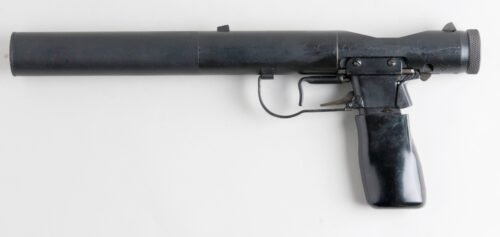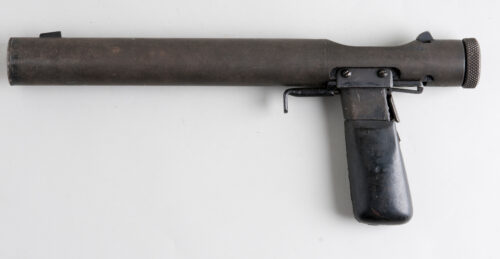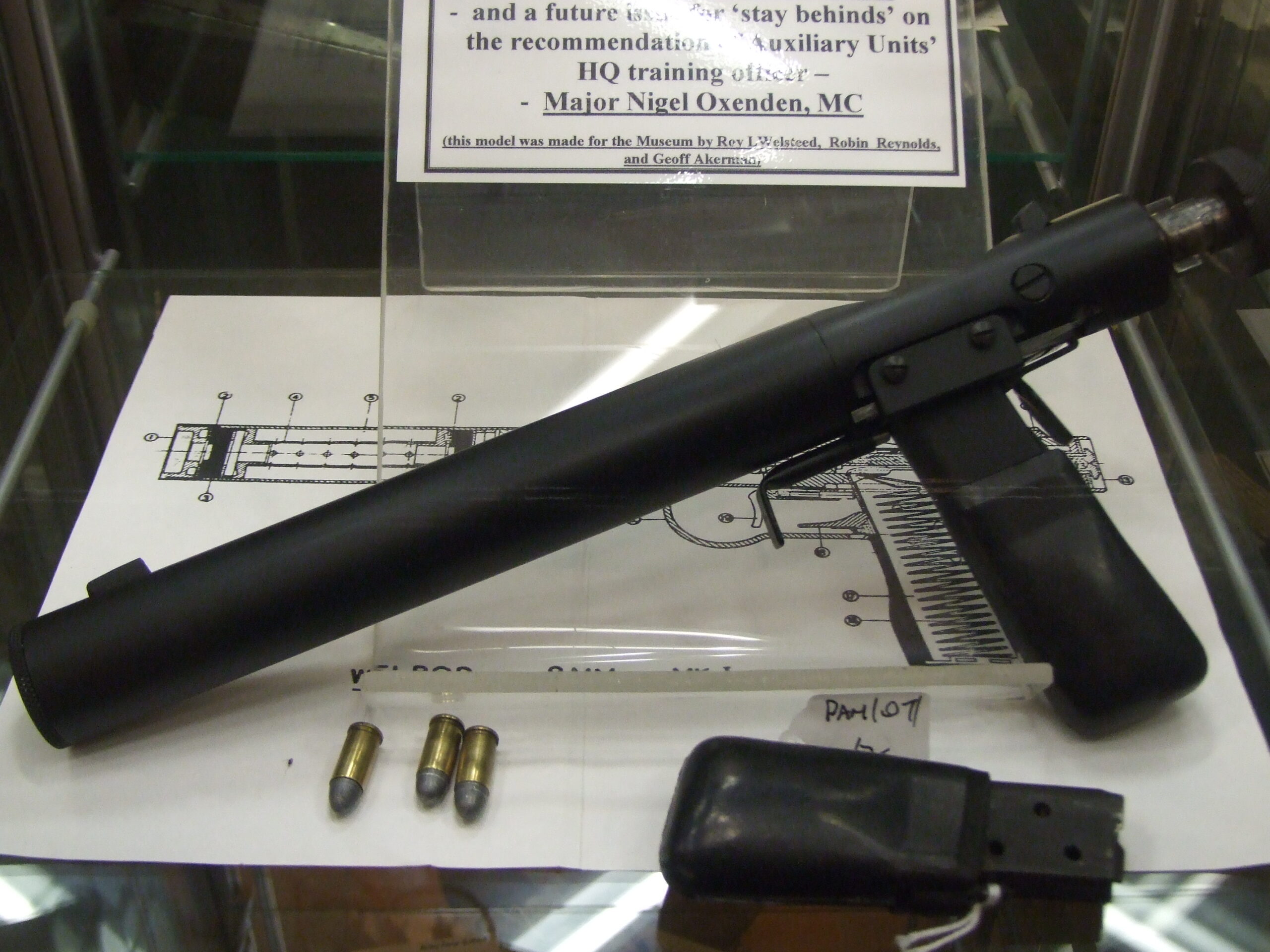Welrod Mk II at Parham Airfield Museum, Parham Airfield, Suffolk. Museum of the British Resistance Organisation. Photo: Gaius Cornelius / CC BY-SA 4.0 DEED.
The Welrod is a fascinating piece of history, a weapon designed for silence and stealth during the tumultuous times of World War II. This British bolt-action, magazine-fed, suppressed pistol was devised by Major Hugh Reeves at the Inter-Services Research Bureau, later known as Station IX.
The facility was heavily guarded and included civilian scientists and craftsmen, as well as military personnel from all three services. It was situated at a mansion called “The Frythe” near the town of Welwyn, about an hour’s drive north from London. It was among several similar workshops and laboratories scattered across England.
Origin and Design
The Welrod’s unusual name is derived from “Wel” from “Welwyn Garden City”, a prefix used by covert equipment designed by Station IX, and “rod”, gangland slang for gun. This naming convention was a way to obscure its purpose. The Welrod was designed from the ground up as a silent weapon for shooting sentries, influencing its unique design.
The Welrod takes the form of a 1.25-inch-diameter (32 mm) cylinder, about 12 in (300 mm) long. The rear section of the cylinder contains the bolt, the middle section, the vented (16–20 ports) barrel and expansion chamber for the barrel and the front section, the baffles and (rubber) wipes of the suppressor.
The Welrod, a British bolt-action, magazine-fed, suppressed pistol from World War II, had two main variants: the Mk I and Mk II, each with distinct features. The Mk I was chambered for 9×19mm, while the Mk II used .32 ACP rounds. In terms of design, the Mark I featured a trigger guard and a front sight positioned halfway along the weapon, rather than near the muzzle. This made the Mk I somewhat longer and heavier than its successor. The Mark I also had a 6-round magazine, compared to the Mk II’s 8-round magazine.

The development of the Welrod began with the original Mk I, a bolt action design. Although 500 units were ordered, it’s unclear if this model ever progressed beyond the prototype stage. The Welrod Mk II, chambered for .32 ACP, became the primary model. A new version of the MK I was later redeveloped using 9×9mm rounds.
Operation and Use
The Welrod is a single-shot weapon which requires the operator to manually cycle the rounds via a rotary bolt action mechanism accessed at the rear of the pistol. The Welrod was equipped with a magazine—one modified from a Colt 1903 pistol which would hold 8 rounds (although in the Welrod, it was recommended to load no more than 5 rounds to prevent malfunctions when cycling). Interestingly, the magazine also functioned as the grip of the gun—it was encased in a thick rubber sleeve to make it big enough to grasp well.
The Welrod’s design was focused on being an extremely quiet gun, thanks to its integrated suppressor. This made it particularly suited for covert operations where discretion was paramount. The manual bolt action mechanism of the Welrod ensured that nothing was moving when the gun fired, thus the only noise was that of the gunshot.

In comparison, many other silenced pistols of the time were adaptations of existing pistol models with added silencers. For instance, the U.S., United Kingdom and other countries fielded many pistol models for covert operations with silencers designed to match their mission profile2. The German army, for example, fielded suppressors for a 9mm Steyr pistol, the Luger P-08, and the Walther P-382.
In the U.S., the Office of Strategic Services (OSS) had a need for a silenced pistol for use on clandestine missions. They contracted with Western Electric Bell Laboratories for the suppressor design. Bell chose the Kulikowski (Polish) silencer as its model. The .22 LR High Standard HDM pistol, based on the High Standard H-D, was one such weapon used by the OSS, and some sources claim it to be the most used silenced weapon of the OSS.
The Welrod was primarily used by the British Special Operations Executive (SOE) but was also used by the OSS and Resistance forces. Approximately 2,800 were made in wartime and perhaps 14,000 in total when post-war examples are included. It is one of the best-remembered pieces of real-life James Bond gear manufactured by SOE.

B&T Station SIX
The B&T Station SIX is a modern, integrally suppressed pistol that traces its lineage back to the covert Welrod pistol of World War I. and the more recent VP9. The Welrod was a British-made, bolt-action, magazine-fed, suppressed pistol used for clandestine operations during the war. The VP9, also known as the Veterinary Pistol 9mm, was a modernized version of the Welrod, designed for covert operations and personal protection. It is not tp be confused with the HK VP9.
The name “Station SIX” pays homage to the Bride Hall weapons acquisition section, also known as SOE Station VI and later Station IV, where the original concept of the Welrod was conceived. The B&T Station SIX maintains the non-descript appearance of its predecessors, making it ideal for covert operations. It features a new grip and updated magazines, enhancing its usability and performance. Despite these updates, it retains the whisper-quiet sound signature that made the Welrod so effective for stealth operations.
One of the unique features of the B&T Station SIX is its rotating bolt operation. This is a feature it shares with the Welrod and the VP9. It contributes to the weapon’s quiet operation. The rotating bolt locks the breech of the gun when firing, preventing the loud noise of gas escaping from the breech that is common in most firearms.
The B&T Station SIX is available in two calibers: 9mm (B&T Station SIX-9) and .45 ACP (B&T Station SIX-45). This gives operators a choice depending on their specific needs and preferences. The .45 ACP model accepts standard 1911 magazines and makes excellent use of easily obtainable subsonic 230-grain loads.
The B&T Station SIX exemplifies the lasting significance of the design concepts that were originally introduced with the Welrod pistol. It combines historical design elements with modern enhancements to create a weapon that is well-suited to the demands of today’s covert operations.
Conclusion
The Welrod, with its unique design and purpose, reflects the ingenuity and resourcefulness of wartime innovation. It serves as a reminder of the length’s nations went to ensure success during one of the most challenging periods in human history. Today, it remains a fascinating piece of history, a silent witness to the covert operations of World War II. It was still in use as recently as the Gulf War. Its legacy continues with the B&T Station SIX.
Source
B&T USA
BT-USA.com
*The views and opinions expressed on this website are solely those of the original authors and contributors. These views and opinions do not necessarily represent those of Spotter Up Magazine, the administrative staff, and/or any/all contributors to this site.

